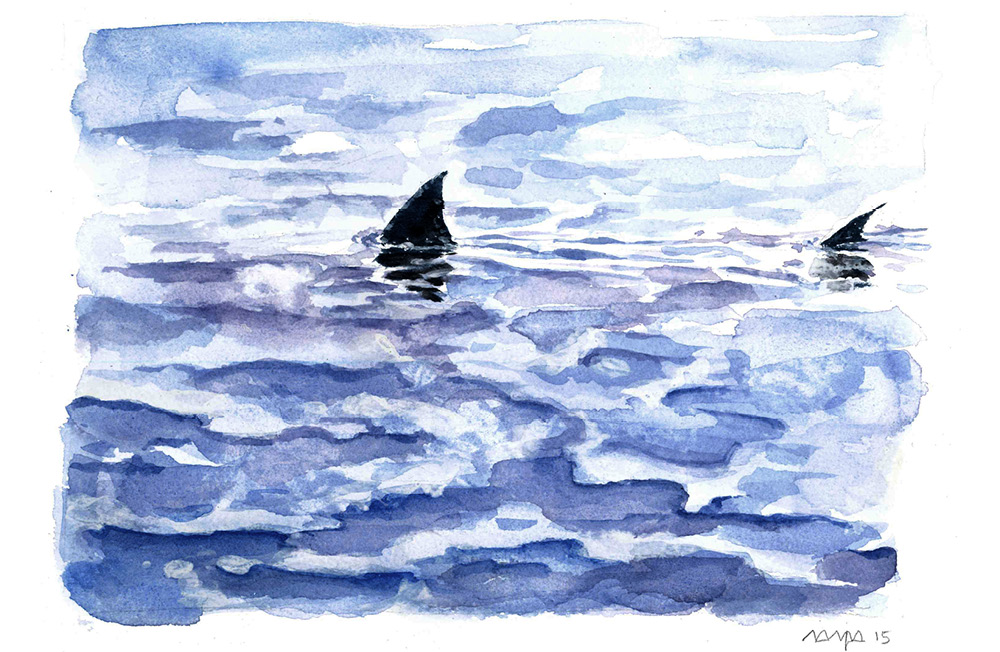The Short History Of Shark Lore
Share
The human brain is the shape of a walnut, has the colour of old cauliflower and the consistency of squid. Dig through all the bulky, functional stuff – squelch – and somewhere deep in there is an ancient part of the whole architecture – the amygdala.
This pea-sized lump runs emotions, sex and deep instinct. Animal stuff, intuition. And it’s the bit that starts firing when you’re sitting in a rivermouth, picking at your bleeding foot and admiring the sunset while your dog – the dog you’ve been wrestling with – barks happily in the distance. Something’s wrong with this picture, says the amygdala. It’s a caveman instinct: predation radar.
Shark fears don’t engage the rational brain. As a result, all the facts in the world don’t ease the dread. We build stories, aphorisms and mantras around the gnawing primordial shivers.
Take the old chestnut “more people die annually from bee stings than shark attacks”. It’s a classic exercise in comparing the incomparable. Maybe more people die from falling paint tins than airborne livestock each year too, but what have we learnt? “You’re more likely to die on the roads on the way to the beach.” Right. Fine. This you can get your head around. But taken to its logical extent, surfing is optional and buying more corn chips is not, so…
Another pub classic: the widespread assumption that sharks can sense fear. I sat next to a South Australian once (I had to: we were surfing) as a dorsal fin circled us. “Keep your heartrate down,” he growled. “They can sense it.” Which immediately caused the inverse to occur. In nature, this is called a feedback loop. If the fin had belonged to a Noah, I was toast.
In the past, the timing of shark sightings was said to correspond closely to cricket season. The problem with this was the advent of the IPL, which put year-round cricket in everyone’s loungerooms, and sure enough, whiteys started to appear in July. It’s hopelessly inexact anyway – what if the cricket’s washed out? What do sharks do if there’s a declaration?
The appearance of dolphins in the surf had always been taken as evidence we’re all safe. With their warm blood and larger cerebellums, the daft logic seemed to be that they’d outwit and outlast a creature with half the brain but six times the evolutionary history. It sounded Zen until a dolphin died from wounds inflicted by a shark off Newy in January. The Tele showed characteristic restraint in describing this routine predatory interaction as “Monster Shark’s Brutal Attack on Dolphin”.
Surfing with dogs is another thing entirely. Dogs don’t occur naturally in the ocean. We introduced them, and they stink. Even the cleanest dogs honk like a million schoolbags full of old lunch and wet jumpers. So it’s no wonder they might attract a carnivore with a phenomenal sense of smell.
Peter Benchley was the scientist, sorry, pop fiction writer, who inadvertently became the backbone of Western Australian shark policy through having popularised the idea that sharks can become addicted to human flesh – “man-eaters”. Of course it makes sense that a predator requiring vast amounts of dietary protein and fat would become hooked on a prey (us) that contains a fraction of the nutrients in its usual food source (seals). It’s the equivalent of us giving up chicken because we’ve got hooked on sparrows. Acceptance of this notion necessitates also accepting that sharks are capable of malice, vengeance and forward planning.
Wetsuit pissing? Regardless of its propensity to attract sharks, it’s never going to stop. Has anyone ever seen a single surfer leave the water and scuttle dripping up to a toilet block to take a leak? No. Does the water in the footwell of my car smell like coffee that’s passed through two kidneys? Yes. Are sharks attracted to asparagus? Unclear.
Ozzie Wright returned from his last trip to South Oz with this story: after surfing a wave two hours’ drive from the nearest human for three hours and feeling the entire time like he was being scoped, he came in only to see a huge white chomp a seal in half right where he’d been taking off (“Crazy Shark In Relentless Feeding Frenzy – A Tele Exclusive!”).
What insight can we gain here? Sharks like art.
